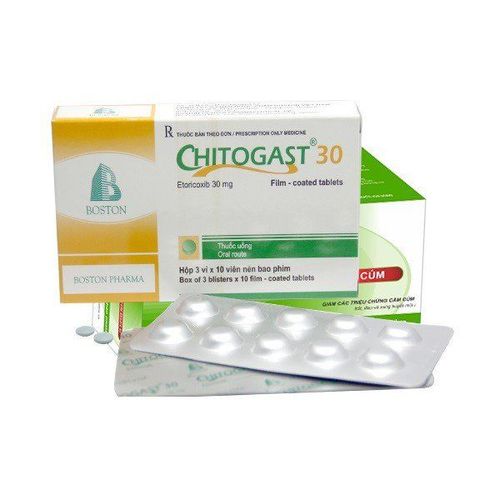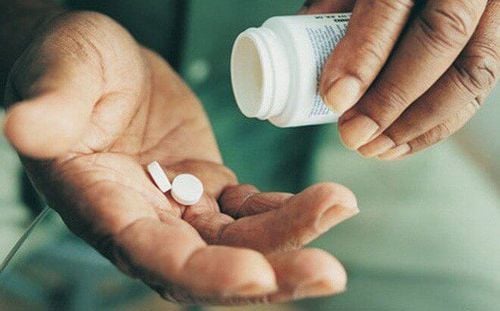This is an automatically translated article.
Chitogast 60 is a non-steroidal anti-inflammatory drug (NSAID) used in the treatment of osteoarthritis and gout. So when using Chitogast 60, what should be noted to be effective and safe?1. Uses of Chitogast 60
Chitogast 60 is a film-coated tablet containing the main ingredient etoricoxib with a strength of 60 mg. Etoricoxib is classified as a prescription drug, with analgesic, antipyretic, and anti-inflammatory effects.
2. Indications and contraindications of Chitogast 60
Chitogast 60 is indicated in the following cases:
Treatment of acute gouty arthritis (acute gout) Symptomatic treatment of primary dysmenorrhea, symptoms of acute and chronic osteoarthritis Treatment Rheumatoid spondylitis Chitogast 60 is contraindicated in the following cases:
Hypersensitivity to the components of the drug or a history of allergy to aspirin or to non-steroidal anti-inflammatory drugs (including COX inhibitors- 2) Gastrointestinal bleeding or peptic ulcer, enteritis Renal failure (ClCr < 30 ml/min), severe liver failure (Child-Pugh score 10) Pregnancy and lactation Children under 16 years History of bronchial asthma, acute rhinitis, nasal polyposis, angioedema Patients with uncontrolled hypertension Peripheral artery disease, ischemic heart disease and cerebrovascular disease.
3. Dosage and how to use Chitogast 60
Chitogast 60 is taken orally, after eating.
Dosage for adults:
Osteoarthritis: starting dose 30 mg/time/day, may increase to 60 mg/time/day if symptoms do not improve Ankylosing spondylitis, rheumatoid arthritis : 90 mg/time/day Acute gout: 120 mg/time/day, up to 8 days Primary dysmenorrhea, acute: 120 mg/time/day Acute pain due to dental surgery: 120 mg/time/day Do not exceed the recommended dose for each indication.
Children and adolescents under 16 years of age: not recommended
Patients with hepatic impairment:
Mild hepatic impairment (Child-Pugh score 5 - 6): dose not to exceed 60 mg/time/day Moderate hepatic impairment ( Child – Pugh score 5 – 6): the dose should not exceed 60 mg/time on alternate days or 30 mg/time/day. Severe hepatic impairment (Chito-Pugh score 10): contraindicated to use Chitogast Patients with renal impairment:
Patients with ClCr ≥ 30 ml/min: no dose adjustment is required. Patients with ClCr < 30 ml/min: contraindicated Use Chitogast
4. Undesirable effects of Chitogast 60
When using Chitogast, you may experience unwanted effects such as digestive disorders, epigastric pain, diarrhea, indigestion, dizziness, headache, muscle pain, increased liver enzymes, leg edema.
5. Chitogast 60 . drug interactions
Chitogast 60 interacts with the following drugs:
Anticoagulants: Patients should be closely monitored for coagulation function, especially at the beginning of treatment or when changing therapy when co-administered with etoricoxib. ACE inhibitors or angiotensin II antagonists (ARBs), diuretics. Chitogast 60 reduces the antihypertensive effect of these drugs. Concomitant use of Chitogast 60 with these drugs may increase the risk of acute renal failure, so it is necessary to monitor the patient's renal function, especially the elderly group. Acetylsalicylic acid: The use of 2 nonsteroidal anti-inflammatory drugs may increase the incidence of peptic ulcers or other complications compared with the use of etoricoxib alone. Cyclosporin and tacrolimus: although there is no clear evidence, the use of non-steroidal anti-inflammatory drugs may increase the nephrotoxicity of cyclosporin and tacrolimus. Therefore, the renal function of the patient should be closely monitored when these drugs are administered concomitantly. Lithium: Chitogast 60 reduces the elimination of lithium, which in turn may increase blood levels of lithium. Methotrexate: 60 mg and 90 mg etoricoxib did not affect methotrexate concentrations. However, a dose of 120 mg was able to increase methotrexate concentrations by 28% and renal clearance of methotrexate by 13%. Therefore, it is necessary to monitor the toxicity of methotrexate when these two drugs are used concurrently. Contraceptives: Etoricoxib may increase the steady state 24-hour AUC of oral contraceptives containing 35 μg ethylestradiol (EE). Therefore, this increase should be borne in mind when Chitogast is co-administered with oral contraceptives. Digoxin: it is necessary to monitor the risk of digoxin toxicity when combining drugs. Rifampicin: Rifampicin can reduce blood levels of etoricoxib by 65% and cause pain recurrence. However, increasing the dose of etoricoxib in each indication has not been studied, so an increase in dose is not recommended in this case. Antacids: The pharmacokinetics of etoricoxib are not affected by antacids.
6. Notes when using Chitogast 60
Use Chitogast 60 with caution in the following cases:
Patients with blood clotting disorders Patients who are dehydrated (diarrhea, vomiting...) Patients with ischemic heart disease, history of heart failure, Left ventricular dysfunction Patients with hypertension: blood pressure should be closely monitored because Chitogast may aggravate hypertension. Patients with elevated liver enzymes (AST and ALT): should discontinue use if symptoms of liver failure or liver enzymes increase 3 times the upper limit of normal. Patients with heart failure, renal failure and cirrhosis: the drug may be nephrotoxic. In addition, Chitogast can mask fever and signs of infection. In some cases, the use of the drug can lead to fatal exfoliative dermatitis, severe hypersensitivity reactions. Therefore, the drug should be discontinued when there are signs of hypersensitivity or redness of the skin, mucosal damage.
Please dial HOTLINE for more information or register for an appointment HERE. Download MyVinmec app to make appointments faster and to manage your bookings easily.













